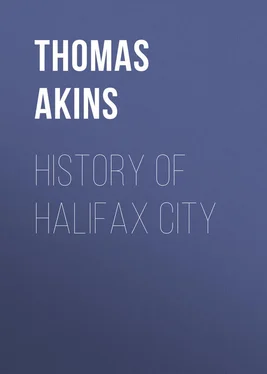Thomas Akins - History of Halifax City
Здесь есть возможность читать онлайн «Thomas Akins - History of Halifax City» — ознакомительный отрывок электронной книги совершенно бесплатно, а после прочтения отрывка купить полную версию. В некоторых случаях можно слушать аудио, скачать через торрент в формате fb2 и присутствует краткое содержание. Жанр: foreign_antique, foreign_prose, Историческая проза, на английском языке. Описание произведения, (предисловие) а так же отзывы посетителей доступны на портале библиотеки ЛибКат.
- Название:History of Halifax City
- Автор:
- Жанр:
- Год:неизвестен
- ISBN:нет данных
- Рейтинг книги:3 / 5. Голосов: 1
-
Избранное:Добавить в избранное
- Отзывы:
-
Ваша оценка:
- 60
- 1
- 2
- 3
- 4
- 5
History of Halifax City: краткое содержание, описание и аннотация
Предлагаем к чтению аннотацию, описание, краткое содержание или предисловие (зависит от того, что написал сам автор книги «History of Halifax City»). Если вы не нашли необходимую информацию о книге — напишите в комментариях, мы постараемся отыскать её.
History of Halifax City — читать онлайн ознакомительный отрывок
Ниже представлен текст книги, разбитый по страницам. Система сохранения места последней прочитанной страницы, позволяет с удобством читать онлайн бесплатно книгу «History of Halifax City», без необходимости каждый раз заново искать на чём Вы остановились. Поставьте закладку, и сможете в любой момент перейти на страницу, на которой закончили чтение.
Интервал:
Закладка:
The plan of the town having been completed and the building lots marked out, in order to prevent dispute and discontent among the settlers, it was deemed best that they should draw for the lots. Accordingly, at a Council held on the 1st of August, it was resolved that on Tuesday following, the 8th of August, all heads of families who were settlers, should assemble at seven o'clock with the overseers, and single men should form themselves into families, four to each family, and each family choose one to draw for them. Mr. Bruce the engineer, being present on the occasion, assisted in distributing the lots according to the arrangement, and the whole were entered in a book of registry which was to be kept for the purpose and to constitute evidence of title and possession. 15 15 This allotment book still remains entire in the office of the Provincial Secretary, in Halifax. It was repaired in 1869 by the Record Commission, and a fac-simile copy made for use and the original placed out of the reach of injury.
The next object of importance was the erection of proper defences for the protection of the settlement. After they had taken possession of the lots, and commenced to build, the Governor endeavoured to induce the people to work for a few days in throwing up a line of defence around their new abode; "but," says he, "there was no persuading them to do it." It was not until the 13th August when the Council voted 1s. 6d. per day to each man employed, that this necessary work was commenced by the settlers. The harbour being broad and easy of access, the difficulty of selecting proper positions for fortifications, which would command the entrance, was at first seriously felt. This had been the great objection on the part of the French to making any settlement at Chebucto, La Have having been chosen by them for the principal post on the Atlantic Coast, being, from its narrow entrance, more easy of defence. In Admiral Darell's plan of Chebucto, the two points that flanked the entrance to Bedford Basin were marked as the places proper to fortify. Mr. Cornwallis says, their view must have been to have the settlement within that Bay (the Basin); this would have been subject to great inconvenience. In the first place, it would have been too far up for the fishermen, it being about five leagues from the entrance of the Harbour to those points, and the beach all along as well adapted for curing their fish as can possibly be imagined; no fisherman would ever have thought of going within these forts. Indeed no ship would choose to go so far, as no finer harbour can be than that of Chebucto, which reaches from these points to Sandwich River; so that notwithstanding any forts upon these points, an enemy's fleet might be secure and indeed block up all ships within the bay. He accordingly fixed upon Sandwich Point and the high lands opposite, (now called York Redoubt), and George's Island as the most proper positions for the erection of the necessary defences. On the latter he immediately placed a guard, landed his stores and planned and proposed to build thereon his magazine for powder.
The first act of Government, after the organization of the Council on the 14th, was an audience of the three French Deputies, who had come down to meet the New Governor. They were Jean Melanson, from Canard River; Claude le Blance, from Grand Pre, and Philip Melanson from Pisiquid. Colonel Mascarine read to the Council the oath which the French inhabitants had before taken. Being asked if they had anything to offer from their several departments, they answered that they were sent only to pay their respects to His Excellency and to know what was to be their condition henceforth, and whether they would be allowed their priests. They were assured that their religion should be protected, but that, as heretofore, no priest should be permitted to officiate within the Province, without having first obtained a license from the Governor. They were furnished with copies of the Royal Declaration, a proclamation issued by Governor Cornwallis, and the oath which had been customary, with directions to return within a fortnight, to report to the Council the views of the inhabitants of the respective districts, and also to notify the other settlements to send deputies as soon as possible. The second meeting of the Council took place on the 17th, when Mr. Wm. Steele was sworn in a member of the Board, and on the following day the Governor's proclamation was read in the camp, prohibiting all persons from leaving the Province without permission, and against the retail of spirituous liquors without license.
On the 18th, Mr. Bruce the Engineer, Lieutenants Ewer, Collier and Mr. John Duport were appointed Justices of the peace, and all the settlers having assembled in separate companies with their respective overseers, each company chose its constables.
The Governor designed opening more perfect means of communication with Minas by constructing a road, which he described as being 30 miles only, in a direct line, and to build a Block House half way, but having only two companies of soldiers with him, one of Hopson's and one of Warberton's regiment, together with about 60 of Goreham's Indian Rangers, and the 50 French, who promised to assist in the work, having disappointed him, he was compelled to postpone the object until after the arrival of the army from Louisburg. Proper access to the interior, by the construction of a good road to Minas, was deemed of paramount importance to the settlement of the country. The inhabitants of the rural districts were so insulated as to be in a great measure independent of all authority. Colonel Mascarine, on returning to Annapolis, received directions to send a Captain, 3 Subalterns and 100 men to Minas, and to erect a Block-house and Battery there, the troops to be first quartered at Grand Pre, where the Block-house was to be built, and the French people were to be hired at fair wages to assist in the work.
Capt. How, who had been sent to St. John River in the Albany with Capt. Rouse, having returned overland with thirteen Indians, three deputies from the tribes at St. John, the Chief of the Chinecto Indians, and nine others of their tribes. They received an audience on the 14th; they consisted of Francis de Salle, Chief from Octfragli; the Chief Noellobig, from Medochig; the Chief Neptune Albodonallilla from the Chignecto tribe, for himself and tribe. The negotiation was carried on through Martin, the Indian, and André, the interpreter from Minas. They stated to the Council that they had come to confirm the treaty of 1726, and that several of them had been present at that treaty. Terms were drawn up by Mr. Secretary Davidson, and signed by the Chiefs on the 15th August, 16 16 Note. – These Indians are described in a letter from one of the Settlers, to England, dated 19th August, as quite different from the Indians of the peninsula, their faces all rubbed over with vermillion and across their nose and forehead are regularly drawn black lines. Their ears are bored full of holes and adorned with tobacco pipes and ribbons of different colours; their clothes are of the light homespun grey but intolerably ragged. The French supply them with those articles. Their squaws or women dress equally as gay as the men. They are entire drunkards, and never cease drinking spirituous liquors as long as they can get it. They came on board to the Governor in great form. After the treaty was ratified they received presents and went on board the man-of-war, where they solaced themselves with singing and dancing. As to the songs it is one continued bellowing and noise. Upon their coming off, the man-of-war gave them a salute of 17 guns, as likewise they did on going aboard. They expressed a great deal of satisfaction at the honors done them; so they were discharged and sent in one of Colonel Goreham's sloops to St. John River with presents to the rest of their tribe.
1749, and Capt. How was ordered to carry it to St. John to be ratified, and to take with him presents to the Chiefs. It was accordingly ratified on the 4th day of September following, and signed by all the Chiefs and Captains at the River St. John, six in number, in the presence of Mr. How and seven other witnesses; Madame De Bellisle acting as interpreter by request of the Indians. This document is still in existence; also a copy of that of 1726, sent to Governor Cornwallis by the Governor of Massachusetts Bay. This treaty appears to have been little regarded, for in the beginning of October following, news arrived from Annapolis and Canso of further incursions on the part of the Indians, and Government was compelled to raise two new independent companies of Volunteers for that service, which were placed under the command of Major Gilman and Capt. Clapham, on the same footing with the Rangers under Gorham.
Интервал:
Закладка:
Похожие книги на «History of Halifax City»
Представляем Вашему вниманию похожие книги на «History of Halifax City» списком для выбора. Мы отобрали схожую по названию и смыслу литературу в надежде предоставить читателям больше вариантов отыскать новые, интересные, ещё непрочитанные произведения.
Обсуждение, отзывы о книге «History of Halifax City» и просто собственные мнения читателей. Оставьте ваши комментарии, напишите, что Вы думаете о произведении, его смысле или главных героях. Укажите что конкретно понравилось, а что нет, и почему Вы так считаете.












